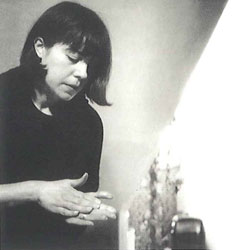Lourdes Castro
Lourdes CastroFunchal ¶ 1930
 |
|
| Créditos fotográficos / Photographic credits: DR/ Cortesia Assírio & Alvim |
She graduated in painting at the Fine Arts School of Lisbon in 1956. ln the subsequent year she travelled to Munich, Germany, with René Bertholo, Costa Pinheiro and a handful of other Portuguese young artists, all recipients of scholarships from the Gulbenkian Foundation. A few months later, in 1958, she moved to Paris, this time only in the company of René Bertholo. Together they founded the KWY group and magazine (existing until 1963). In her early work, there was a clear predominance of an lnformalism-influenced abstractionism, which slowly yet progressively would return to neo-figurativism. ¶ Normal 0 21 false false false PT ZH-CN AR-SA MicrosoftInternetExplorer4 /* Style Definitions */ table.MsoNormalTable {mso-style-name:"Tabela normal"; mso-tstyle-rowband-size:0; mso-tstyle-colband-size:0; mso-style-noshow:yes; mso-style-priority:99; mso-style-qformat:yes; mso-style-parent:""; mso-padding-alt:0cm 5.4pt 0cm 5.4pt; mso-para-margin-top:0cm; mso-para-margin-right:0cm; mso-para-margin-bottom:10.0pt; mso-para-margin-left:0cm; line-height:115%; mso-pagination:widow-orphan; font-size:11.0pt; font-family:"Calibri","sans-serif"; mso-ascii-font-family:Calibri; mso-ascii-theme-font:minor-latin; mso-hansi-font-family:Calibri; mso-hansi-theme-font:minor-latin; mso-bidi-font-family:Arial; mso-bidi-theme-font:minor-bidi;} The artist's path would lead her through the abandonment of the most traditional of methods, means and supports, dedicating herself to an interdisciplinary work process, which would begin with the first neo-dada "assemblages", albeit within the panorama of the then contemporary French "nouveau réalisme", in which the random-like amalgamation of small objects inside boxes goes through a uniform monochromatization using aluminium paint. The form's aura that would become attached to the newly created object converts itself into a process of subtle affirmation of the possible outline that the objects or the people can attain. This can be seen, for instance, with the people drawn only in their outer contours in Sombras (Shadows), a theme that from the 60s onwards would become not only essential to her work, but constant, given the fact that it is still present in her more contemporary pieces. Whether over sheets, plexiglas or fluorescent acrylic cut-outs, Lourdes Castro amplifies the two-dimensionality of the tableaux, and gives it a new thickness, a new visual three-dimensionality. The author creates a paradox out of her own time's artistic clash, the one between art's objectification and dematerialization, leaving behind the previous central issue, representation. After the early 80s, Lourdes Castro created a series of drawings, entitled Sombras à Volta de um Centro (Shadows About a Centre). These prolong the very reflective sense of temporality and life's destinies, by employing "objects" of Nature as an interpretation of the Romantic cultural tradition. In 2000, Lourdes Castro was awarded the Grand Prix EDP for the Visual Arts after participating in that same year's São Paulo biennial with an installation co-created with Francisco Tropa: an immense white fabric on top of a huge, long table strongly lightened upon, in such a way that the folds of the fabric were much accentuated.
View the embedded image gallery online at:
http://cvc.instituto-camoes.pt/biografias-en/lourdes-castro-41680.html#sigFreeId841601ab01
http://cvc.instituto-camoes.pt/biografias-en/lourdes-castro-41680.html#sigFreeId841601ab01


